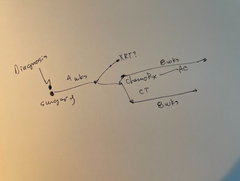Introduction
We often hear the diagnosis of breast cancer and lose sight of the fact that there are several types of breast cancer. In the US, and much of the Western world, the most common form of breast cancer is called hormone-positive or estrogen receptor positive breast cancer. Hormone-positive breast cancer is a type of breast cancer that relies on hormones like estrogen and progesterone to signal the cancer cells to grow. Doctors can treat hormone positive cancer with hormone therapies that help block the action of these hormones and slow down or stop the cancer from growing. Tamoxifen is one of these types of “hormone blocking” medicines for breast cancer that can lower the chance of it coming back and spreading. It is taken as a pill every day and works by protecting the cancer cells from the estrogen signaling growth signal. Tamoxifen engages and clogs up the estrogen receptor in the cancer cell. Paradoxically, Tamoxifen can stimulate growth in other cells of the body with estrogen receptors. For example, cells of the uterine lining can grow when their receptors are engaged with tamoxifen.
Like most medicines, tamoxifen has side effects. The side effects often occur in parts of the body which have cells with estrogen receptors. One of the beneficial side effects of tamoxifen is stimulation of cells which help form bone; tamoxifen can help prevent osteoporosis or bone loss. One of the known but uncommon side effects of tamoxifen is endometrial (uterine) cancer, which is likely caused by tamoxifen signaling the uterine lining cells to grow. So what happens when you stop tamoxifen? One thing we hear from our community is that some women experience a heavy period after stopping. Let’s break that down below.
Understanding Tamoxifen
Let’s go through some of the basics about Tamoxifen.
What is Tamoxifen?
Tamoxifen is a drug used by some people who have been diagnosed with Hormone Receptor-Positive Breast Cancer. If we think of each cancer cell like a little car, hormones such as estrogen and progesterone signal those cells to accelerate their growth and make it possible for them to spread. To stop those cells from getting the signal, doctors try to stop (or block) any estrogen or progesterone from being present in the body, or from reaching the gas pedal. The theory is that if we take away the growth signal, we lower the risk of the cancer cells growing and spreading. That is why Tamoxifen is called a hormone-blocking medicine.
There are several subtypes of breast cancer, but the main ones are divided into three common categories (note that there can be overlap between the first two categories):
- Hormone Receptor-Positive Breast Cancer: This type of breast cancer is sensitive to hormones like estrogen and progesterone. It includes subtypes like estrogen receptor-positive (ER+), progesterone receptor-positive (PR+), or both (ER/PR+).
- HER2-Positive Breast Cancer: In this subtype, the cancer cells have too much of a protein called HER2, which also acts as a growth signal in the cancer cells.
- Triple-Negative Breast Cancer: This type does not have hormone receptors (ER/PR) or excess HER2 protein.
Tamoxifen can be used by women both before and after menopause. For those at a higher risk of developing breast cancer, some doctors might recommend taking tamoxifen as a preventive measure to reduce the chances of developing cancer Additionally, for women who have already been treated for breast cancer, tamoxifen can be used to help prevent the cancer from coming back. The duration for taking tamoxifen varies and is typically decided by the doctor based on individual circumstances. A 2021 article in the ASCO Post summarizes current thinking about taking Tamoxifen for 5 years versus 10 years. The benefit of taking Tamoxifen for longer than the standard 5 years is based on the stage of cancer at diagnosis and various risk factors for recurrence, and can be tailored to an individual’s circumstances by a doctor. It's important to follow the doctor's advice and take the medication as prescribed to maximize its effectiveness in managing and preventing breast cancer.
Common Uses of Tamoxifen in Breast Cancer Treatment
Tamoxifen is commonly used for hormone receptor-positive breast cancer. This means that the cancer cells grow in response to estrogen signaling to the cancer cell. By blocking estrogen signaling, tamoxifen helps slow down or stop the growth of these cancer cells. It is usually taken for 5 to 10 years to reduce the risk of cancer recurrence.
Heavy Periods Post-Tamoxifen: What’s Happening?
Why Do Heavy Periods Occur After Stopping Tamoxifen?
After stopping tamoxifen, many women experience changes in their menstrual cycle, including heavy periods. This happens because tamoxifen affects the estrogen-related hormones in your body. It’s complicated, but normal estrogen levels are regulated by a complex and cyclic interaction between luteinizing hormone (LH), follicle stimulating hormone (FSH), gonadotropin releasing hormone (GnRH), and others. When you stop taking tamoxifen, these hormone levels can fluctuate and lead to heavier menstrual bleeding.
Hormonal Changes and Their Impact on the Menstrual Cycle
Hormones regulate your menstrual cycle. When you stop tamoxifen, your body needs time to adjust to the new hormone levels. This adjustment period can cause irregular or heavy periods as your body finds its new balance.
How Tamoxifen Affects the Endometrium
Tamoxifen can also affect the lining of your uterus, known as the endometrium. It can cause the endometrium to thicken, which might lead to heavier periods or spotting. This is why it's important to keep an eye on any changes in your menstrual cycle and talk to your doctor if you notice anything unusual. If you need a reminder to write down your symptoms, check out our Manta Planner which provides an easy way to remember side effects you are experiencing between doctor’s appointments.
Managing Heavy Periods After Tamoxifen
So you’re done with tamoxifen (yay!), but now you’re dealing with a heavy period as a result (boo!). Let’s talk about some things to help deal with that.
Practical Tips and When to Seek Medical Advice
Managing heavy periods can be challenging, but there are ways to make it easier. Here are some practical tips:
- Track Your Cycle: Keep a diary of your periods, noting the flow and any other symptoms. This can help your doctor understand what’s going on.
- Stay Hydrated: Drink plenty of water to help your body cope with heavy bleeding.
- Eat Iron-Rich Foods: Foods like spinach, red meat, and beans can help replenish the iron you lose during heavy periods.
- Use the Right Products: Make sure you have the right menstrual products, like high-absorbency pads or tampons, to manage your flow comfortably.
Just as a reminder, many women taking tamoxifen undergo natural menopause during their time taking tamoxifen. So, normal periods may not resume, or they may resume irregularly as the ovarian function “sputters out.” Because the normal ovary produces estrogen and eggs, be mindful of the possibility of pregnancy at this time.
When to Seek Medical Help
It’s crucial to consult your doctor if your periods are very heavy, last longer than usual, or if you experience severe pain. Your doctor can offer treatments to help manage heavy bleeding, such as hormonal therapies or other medications. In some cases, further tests may be needed to rule out other conditions.
Cancer Maps to help you find your way, one decision at a time.Built for Patients, by Patients. Backed by World-Leading Oncologists

How Manta Cares Can Help
Our team at Manta Cares has all been impacted by cancer - as patients care partners, survivors and oncologists treating patients. We get it! We are here to walk with you as you go through your own cancer experience. Please don’t hesitate to reach out with any questions. Be sure to subscribe to our newsletter and check out our free resources like our Chemotherapy Checklist for Caregivers, Financial Checklist for Cancer Treatment and more. We also put out a bi-weekly podcast called the Patient from Hell to educate, empower and hopefully inspire you as you go through this crappy experience. You can listen on Spotify, Apple Podcasts, YouTube or anywhere you listen to podcasts. Dealing with cancer as a patient or caregiver can feel really lonely. Just know that you are not alone in this experience.
Related Articles:
- Can Claritin Help With Joint Pain From Breast Cancer Treatment?
- Side Effects of AC followed by Taxol Chemotherapy
- Taxol 12 Weekly Treatments Side Effects
- Tamoxifen Withdrawal Symptoms
Conclusion
Understanding and managing health issues like heavy periods after stopping tamoxifen is crucial for your overall well-being. Breast cancer and its treatments can often be the “gift that keeps on giving.” Sometimes the medicines we take to help combat cancer, like tamoxifen, can create their own list of issues. Have you experienced a heavy period after taking tamoxifen? Did you find anything specific that helped you? Comment below with any tips or advice you have for others going through the cancer experience. Join our community for more resources and information to help you navigate your own cancer experience. And know that you are not alone in your experience. We’re in this together!
Take charge with free, expert-crafted resources from Manta Cares—designed to support and empower cancer patients and their caregivers every step of the way. Explore now!
-
FREE Chemotherapy Checklist for Caregivers
- FREE Quick Start Guide to a Cancer Diagnosis
- FREE Gift-Giving Guide
- FREE Caregiver Communication Guide
- Life Wheel Audit: A simple exercise to re-center, re-prioritize and re-start new habits
- Eating the rainbow. Free shopping guide
- Free Financial Checklist for Cancer Treatment
- FREE Reflection Exercise
FAQs on Heavy Priod after Stopping Tamoxifen
Q: Does stopping tamoxifen cause bleeding?
Ans - Yes, stopping tamoxifen can sometimes cause bleeding. This happens because your body is adjusting to changes in hormone levels.
Q: Does tamoxifen make periods heavier?
Ans - Yes, tamoxifen can make periods heavier for some women. It affects the lining of the uterus, which can lead to increased bleeding.
Q: How long does it take for your period to return after tamoxifen?
Ans - It can take a few months for your period to return after stopping tamoxifen. Everyone's body is different, so the exact time can vary. Remember, if you’re at an age where menopause is a possibility, your periods may not return after taking tamoxifen as your body completes the process of menopause.
Q: Can stopping tamoxifen cause weight loss?
Ans - Stopping tamoxifen may lead to weight changes, including weight loss. However, this is not common for everyone and varies by individual.
Q: Does tamoxifen cause belly fat?
Ans - Tamoxifen can cause weight gain, including belly fat, in some people. Hormonal changes due to the medication might lead to changes in fat distribution.
Q: How do you get rid of tamoxifen belly?
Ans - To reduce belly fat after tamoxifen, focus on a healthy diet and regular exercise. Consulting a healthcare provider for personalized advice can also be helpful.
Q: What happens after 5 years of tamoxifen?
Ans - After 5 years of tamoxifen, your doctor will evaluate your treatment plan. They might stop the medication or switch you to another treatment to prevent cancer recurrence.
Q: How many people stop taking tamoxifen?
Ans - Some people stop taking tamoxifen due to side effects or personal reasons. It's important to talk to your doctor before making any changes to your treatment, as there are ways to reduce or eliminate tamoxifen side effects.
Q: What effects does tamoxifen have on metabolism?
Ans - Tamoxifen can slow down your metabolism, making it easier to gain weight. This change can be managed with a healthy lifestyle and regular physical activity.
Q: Does tamoxifen suppress appetite?
Ans - Tamoxifen does not usually suppress appetite. In fact, some people may experience an increase in appetite while taking the medication.
Q: Can there be bleeding after stopping tamoxifen?
Ans - Yes, some people experience bleeding after stopping tamoxifen. This is due to hormonal changes as your body adjusts.
Q: What is breakthrough bleeding on tamoxifen?
Ans - Breakthrough bleeding on tamoxifen is unexpected bleeding that occurs between menstrual periods. It can happen due to changes in the uterine lining caused by the medication. Breakthrough bleeding should be discussed with your doctor or health care provider.
Q: How quickly can tamoxifen cause uterine cancer?
Ans - Tamoxifen slightly increases the risk of uterine cancer, but it usually takes many years to develop. Regular check-ups with your doctor can help monitor for any signs.
Disclaimer: The content provided by Manta Cares Inc. is intended for educational purposes only and is not a substitute for professional medical advice, diagnosis, or treatment. Always seek the advice of your physician or other qualified health providers with any questions you may have regarding a medical condition. Never disregard professional medical advice or delay seeking it because of something you have read on this website.
While we strive to keep the information up to date and correct, we make no representations or warranties of any kind, express or implied, about the completeness, accuracy, reliability, suitability, or availability with respect to the website or the information, products, services, or related graphics contained on the website for any purpose. Any reliance you place on such information is therefore strictly at your own risk.
The use of our platform does not create a doctor-patient relationship. Manta Cares Inc. does not recommend or endorse any specific tests, physicians, procedures, opinions, or other information that may be mentioned on the site. Reliance on any information provided by Manta Cares Inc., Manta Cares Inc. employees, others appearing on the site at the invitation of Manta Cares Inc., or other visitors to the site is solely at your own risk.
The site may contain health- or medical-related materials that are sexually explicit. If you find these materials offensive, you may not want to use our site. The site and the content are provided on an "as is" basis.





